Honda
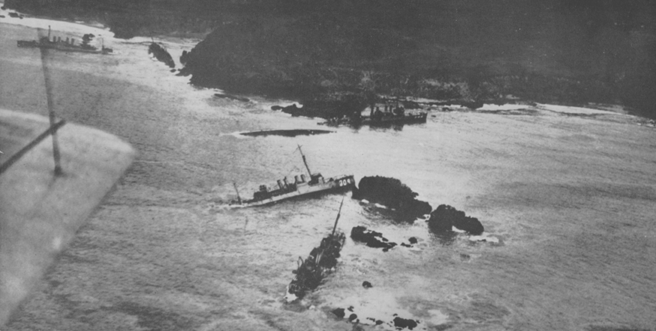
Considered the worst peacetime disaster in United States Naval history, this Aerial photograph shows the final resting place of seven destroyers that wrecked at Point Pedernales, California, an area commonly known as Honda.
THE TRAGEDY AT HONDA
On 8 September, 1923, DesRon 11 under Captain E. H. Watson was on their way to San Diego, California. Engaged in a high-speed 20 knot engineering run down the Pacific Coast, the squadron changed course 95° at 2100 to make the approach to Santa Barbara Channel. Led by the leader, Delphy (DD-261), the squadron steamed into the worsening weather. Shortly after 2105, tragedy struck Squadron 11's ships, one by one. Delphy - unfortunately basing her movements on an inaccurate navigational bearing - made the fateful turn believing she was heading into the Santa Barbara Channel. In fact, she was headed - as were all of the ships astern of her in follow-the-leader fashion - for jagged rock pinnacles and reefs off Point Arguello which was known as Honda, or the Devil's Jaw.
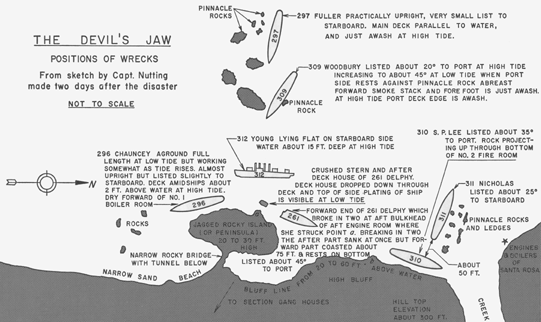
A view of the disaster two days later showing the positions of the destroyers relative to the rocks of Devils Jaw. This was reprinted without permission from "Tragedy at Honda" by Charles Lockwood & Hans Adamson.
Delphy ran hard aground. Though warning signals were sent up by the flagship, the sheltering configuration of the coast line prevented their recognition by the remaining ships of DesRon 11- and, in the ensuing confusion, six other destroyers, S. P. Lee, Young, Woodbury, Fuller, Chauncey, and Nicholas ran aground also. Some of the destroyers farther astern saw what was happening and managed to avoid disaster by quick-thinking seamanship.
Delphy was stranded on the rocks. She crashed broadside and broke in half, her stern below the surface, suffering three dead and 15 injured. Chauncey stranded upright, high on the rocks, near Young (DD-312), which had capsized. With none of her men lost, Chauncey at once went to the aid of her stricken sister, passing a line by which 70 of Young's crew clambered hand-over hand to Chauncey. Swimmers from Chauncey then rigged a network of lifelines to the coastal cliffs, and both her men and Young's reached safety by this means. The abandoned Chauncey was wrecked by the pounding surf. Fuller, last in the column, was abandoned, all of her crew reaching safety, and later broke in two and sank. Woodbury came to rest alongside a small island later nicknamed "Woodbury Rock" that she used as a permanent anchor. Volunteers took across four lines and rigged them across the gap of tumbling surf between the destroyer and the rock that would later bear her name. Meanwhile, although water was pouring into the forward boiler room and engine room spaces, Comdr. Louis P. Davis, the ship's commanding officer, ordered full speed astern. Ens. Horatio Ridout, the engineer officer, and his men worked with great courage to try to produce the horsepower necessary to get the ship out of her predicament, but their efforts were brought to naught when all power failed, due to the flooding, at 2230. As the floodwaters below engulfed and drowned out her power supply and it became impossible to move the ship, Comdr. Davis turned to his reserve plan. While Woodbury settled astern, the thundering breakers struck her full force, causing her bow to rise and fall rhythmically. The hawsers tenuously connecting the ship with "Woodbury Rock" stretched taut and then sagged with the movement of ship and sea. Nevertheless, one by one, Woodbury's crew clambered across the chasm, monkey fashion, in a well-organized abandon ship operation. Later, men from the stranded sister ship Fuller (DD297) reached "Woodbury Rock." Ultimately, all of Woodbury's crew reached safety, some taken off to Percival (DD-298) by the fishing boat Bueno Amor de Roma, under the command of a Captain Noceti. The rough log entry for Woodbury, dated 9 September 1923, sums up the ship's status as of that date: "Woodbury on rocks off Point Arguello, Calif., abandoned by all hands and under supervision of a salvage party composed of men from various 11th squadron ships."
All efforts to save S.P.Lee proved futile, and the ship was abandoned the following day and declared a total loss. Her wreckage was sold on 19 October 1925 to Robert J. Smith of Oakland, Calif. He removed some of the destroyer's equipment but was unable to salvage her hull.
Nicholas skipper Lt. Comdr. Herbert Roesch, did his utmost to prevent the loss of the destroyer as the heavy seas broke over her and Honda's rocks pushed into her hull, but the ship was taken by currents and drifted slowly astern, coming to a stop stern high on a clump of rocks with a 25° list to starboard. Throughout the night, the four stackers crews strove valiantly in the face of Honda's heavy odds, but in the morning as the waves mounted and Nicholas' situation became critical, the Captain ordered "Abandon Ship" Accomplished without loss of life, the order brought the entire crew ashore safely. The discipline and performance of duty was so outstanding that of the seven destroyers, only 23 lives were lost to the treacherous sea. After a number of abortive bids, the destroyer was finally sold 19 October 1925 to Robert J. Smith of Oakland, Calif. Though some equipment was salvaged from the wrecked ship her hull was left to the mercy of the sea in the "graveyard of the Pacific."
Young's hull was torn by a jagged pinnacle and she swiftly capsized heeling over on her starboard side within a minute and a half, trapping many of her engine and fire room personnel below. Lt. Comdr. William L. Calhoon Young's commanding officer, knew that there was no time to launch boats or rafts as the ship's list increased alarmingly following the grounding. Calhoun accordingly passed the word, through his executive officer, Lt. E. C. Herzinger, and Chief Boatswain's Mate Arthur Peterson, to make for the port side, to stick with the ship, and to not jump. While the survivors clung tenaciously to their precarious, oily, surf-battered refuge, Boatswain's Mate Peterson proposed to swim 100 yards to a rocky outcropping to the eastward known as Bridge Rock. Before he could do so however, Chauncey (DD-296) providentially grounded between Young and Bridge Rock, shortening the escape route considerably. The two ships were about 75 yards apart. At that juncture, Peterson unhesitatingly risked his life, diving into the swirling sea and swimming through the tumbling surf with a line to the nearby Chauncey also aground but in a far better predicament since she had remained on a comparatively even keel. Eager hands from Chauncey hauled Peterson aboard and made the line fast. Soon, a seven-man life raft from the sister ship was on its way to Young as a makeshift ferry. The raft ultimately made 11 trips bringing the 70 Young survivors to safety. By 2330, the last men of the crew were on board Chauncey; at that point, Lt. Comdr. Colhoun and Lt. Herzinger (the latter having returned to the ship after having been in the first raft across) left Young's battered hull. In the subsequent investigation of the "Point Honda Disaster" the Board of Investigation commended Lt. Comdr. Calhoun for his "coolness, intelligence, and seamanlike ability" that was directly responsible for the "greatly reduced loss of life." The Board also cited Boatswain's Mate Peterson for his "extraordinary heroism" in swimming through the turbulent seas with a line to Chauncey; Lt. Herzinger drew praise for his "especially meritorious conduct" in helping to save the majority of the ship's crew. Rear Admiral S. E. W. Kittelle, Commander, Destroyer Squadrons, subsequently cited Lt. Comdr. Calhoun's display of leadership and personality that saved "three quarters of the crew of the Young" and Lt. Herzinger for his "Coolness and great assistance in the face of grave danger." Also commended by the admiral was Fireman First Class J. T. Scott, who attempted to close off the master oil valve to prevent a boiler explosion, volunteering to go below to the fire room and go below the floor plates. The water, rapidly rising through the gashes in the shin's hull, however, prevented Scott from completing. the task. He survived. Twenty men were lost in Young, the highest death toll of any of the ships lost in the disaster at Point Honda.
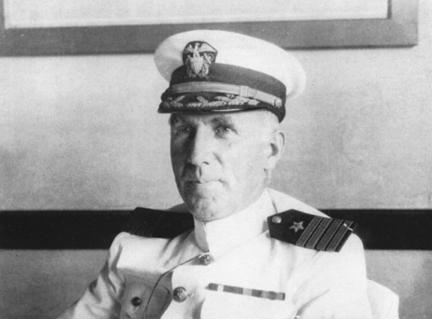
Capt. Edward H. Watson, USN Commodore of DesRon 11.
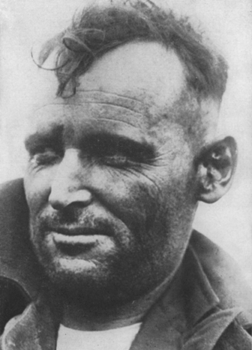
One of the heroes of Honda, Chief Boatswain's Mate Arthur Peterson, who swam from the Young (DD-312) to the Chauncey (DD-296) to set up a line for his shipmates to ferry themselves across to the Chauncey which was is substantially better condition. Ultimately, 11 trips were made allowing nearly 70 sailors to escape the Young. He was recommended for a citation for his bravery.
| Other Names: | Date of Sinking: 8 Sept. 1923 | |||
| Rig/Type: | Cause of Sinking: Stranded | |||
| Length: 314' | Breadth: 31.8' | Tons: 1,190 | Cargo: None | |
| Built: 18 July 1918 | Location: Off Pt. Pedernales | |||
| Hull Construction: Steel | Coordinates: Available to CWD Members | |||
| Depth: 20-40' | Visibility: 20-50' | |||
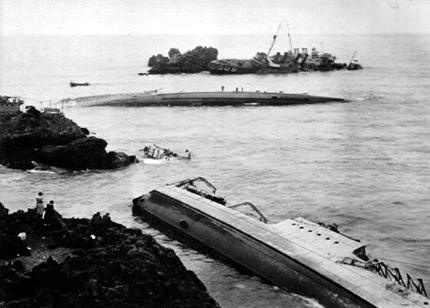
The Delphy (DD-261) sits broken in two pieces in the foreground. The Young (DD-312) lies on it's side behind the Delphy, while the Woodbury (DD-309) lists to the port side in the rocks. The Fuller's (DD-297) funnels are just visible behind the Woodbury.
Delphy (DD-261) was launched 18 July 1918 by Bethlehem Shipbuilding Corp.,
Squantum, Mass.; sponsored by Mrs. W. S. Sims, wife of Rear Admiral Sims and commissioned
30 November 1918, Commander R. A. Dawes in command. Before joining the Atlantic Fleet
Delphy tested submarine detection devices at New London from 23 to 31 December 1918
and aided survivors from Northern Pacific, stranded off Fire Island, N.Y., on New Year's
Day, 1919. Delphy sailed from New York 13 January for winter maneuvers and torpedo
practice in the Caribbean. Returning to New York 14 April with the Fleet, she sailed for
Boston on the last day of the month for operations in preparation for the first
transatlantic seaplane flight. Delphy sailed 19 November 1919 from Boston for the west
coast, arriving at San Diego 22 December. She joined Destroyer Squadrons, Pacific Fleet,
at San Diego for torpedo practice and recovery until placed in reserve 12 June.
Delphy lay at San Diego until 27 December when she sailed with the other ships of Reserve
Destroyer Division for Bremerton, Wash., arriving 4 January 1921 for an extended overhaul
at Puget Sound Navy Yard. Between 22 July 1921 and 20 March 1922 Delphy operated
from San Diego with 50 percent of her complement, then was overhauled. She cruised with
the Battle l Fleet for exercises off Balboa from 6 February to 11 April 1923, then carried
out experiments with torpedoes off San Diego. On 25 June she got underwater with Destroyer
Division 31 for a cruise to Washington for summer maneuvers with the Battle Fleet on the
return passage. She was decommissioned as of 26 October 1923, and sold as a wreck 19
October 1925.
| Other Names: | Date of Sinking: 8 Sept. 1923 | |||
| Rig/Type: | Cause of Sinking: Stranded | |||
| Length: 314' | Breadth: 31' | Tons: 1,215 | Cargo: | |
| Built: 29 Sept 1918 | Location: Off Pt. Pedernales | |||
| Hull Construction: Steel | Coordinates: Available to CWD Members | |||
| Depth: 20-40' | Visibility: 20-50' | |||
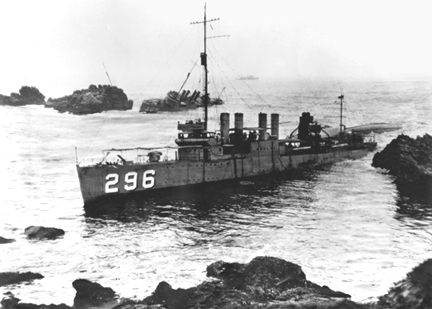
The second Chauncey (Dl)-296) was launched 29 September 1918 by Union Iron Works, San Francisco, Calif.; sponsored by Miss D. M. Todd; commissioned 25 June 1919, Commander W. A. Glassford, Jr., in command; and reported to the Pacific Fleet. From the time of her commissioning, Chauncey sailed from San Diego and Mare Island to Hawaii and along the Pacific coast taking part in fleet exercises, gunnery practice, and other training activities. From 15 July 1920 to 14 October 1921, she was in ready reserve at San Diego and Mare Island, then returned to active duty as flagship of Destroyer Division 31.She was decommissioned 26 October 1923.
| Other Names: | Date of Sinking: 8 Sept. 1923 | |||
| Rig/Type: | Cause of Sinking: Stranded | |||
| Length: 314' | Breadth: 31' | Tons: 1,215 | Cargo: | |
| Built: 5 Dec. 1918 | Location: Off Pt. Pedernales | |||
| Hull Construction: Steel | Coordinates: Available to CWD Members | |||
| Depth: 20-40' | Visibility: 20-50' | |||
The first Fuller (DD 297) was launched 5 December 1918 by Bethlehem Shipbuilding Corp., San Francisco Calif., sponsored by Miss Gladys Sullivan, and commissioned 28 February 1920, Lieutenant Commander R. E. Rogers in command. After a brief cruise to the Hawaiian Islands Fuller arrived at her home port, San Diego, 28 April 1920 and at once took up the schedule of training which took the Pacific destroyers along the west coast from California to Oregon. In February and March 1923, she joined in Battle Fleet maneuvers in the Panama Canal Zone, and returned to experimental torpedo firing and antiaircraft firing practice off San Diego. In July 1923, with her division, she sailed north for maneuvers and repairs at Puget Sound Naval Shipyard. She was decommissioned 26 October 1923.
| Other Names: | Date of Sinking: 8 Sept. 1923 | |||
| Rig/Type: | Cause of Sinking: Stranded | |||
| Length: 314' | Breadth: 30' | Tons: 1,308 | Cargo: | |
| Built: 3 Oct. 1918 | Location: Off Pt. Pedernales | |||
| Hull Construction: Steel | Coordinates: Available to CWD Members | |||
| Depth: 20-40' | Visibility: 20-50' | |||
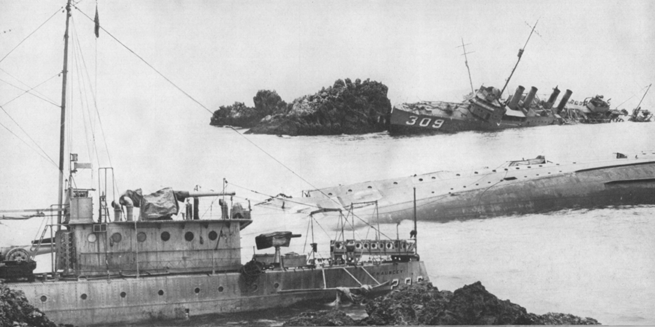
The Woodbury (DD-309) wrecked on the rocks. The destroyer in front is the Chauncey (DD-296) with the Young (DD-312) lying on its side.
The third Woodbury (Destroyer No. 309) was laid down on 3 October 1918 at San Francisco, Calif., by the Union Iron Works plant of the Bethlehem Shipbuilding Corp., launched on 6 February 1919- sponsored by Miss Catherine Muhlenberg Chapin, the daughter of newspaper publisher W. W. Chapin; reclassified DD-309 on 17 July 1920; and commissioned at the Mare Island Navy Yard, Vallejo, Calif., on 20 October 1920, Lt. Comdr. Frank L. Lowe in command. Woodbury departed San Francisco on 22 November and reached San Diego, her assigned home port, the following day. Woodbury moored at the Reserve Docks, where she remained into 1921. The destroyer - like many of her numerous sisters begun during World War I - had entered service at a time when the post-World War I cutbacks in funds and personnel had seriously curtailed American peacetime naval operations. Accordingly, she was placed in a "rotating reserve" established by the Navy to maintain a "force in readiness." In operation, the system required that one-third of a given force remain pier side, maintained by only the minimum number of officers and men, while another third was to be half-manned as it remained berthed at a buoy in the harbor. The last third was fully manned and remained at buoys in the harbor but for periodic operations underway at sea. Woodbury departed her mooring at the Reserve Docks on 1 February 1921 and, over the next few days, conducted torpedo practices and made a 30-knot speed run off the southern California coast. During that brief underway period, the destroyer conducted her operations during the day and returned to her mooring buoy in the evenings. She remained largely port- bound from March to May, but moved to San Pedro, Calif., on 14 June. There, her crew assisted in preservation and maintenance work on William Jones (DD-308) while she lay in dry-dock at the Los Angeles Ship Building and Dry Dock Co., San Pedro. Woodbury then underwent a dry-docking herself for the application of anticorrosive and antifouling paint to her bottom. Woodbury later returned to San Diego and, but for a run via Los Angeles harbor, to Seattle, Wash., stayed there for the remainder of 1921. Underway on the morning of 14 January 1922, Woodbury led Nicholas (DD-311), S. P. Lee (DD-310), and Young (DD-312) to sea. She arrived off Goat Island, near San Francisco, at 0820 the following day and lay to, embarking passengers for transportation to the Puget Sound Navy Yard, Bremerton, Wash., before she resumed her cruise up the Pacific coast. The destroyer reached Puget Sound on the afternoon of the 18th, discharged her passengers, and soon commenced her scheduled overhaul. Woodbury remained at Puget Sound through March 1922. She got underway for San Diego on 3 April but put into Port Angeles, Wash., when Nicholas developed a machinery casualty. Upon completion of Nicholas' repairs, Woodbury resumed her passage southward and reached San Diego on 8 April. The destroyer lay at berth 35, San Diego harbor, into the summer, again as part of the inactive arm of the "rotating reserve." From early July to late September, Woodbury provided essential maintenance and upkeep services to her sister ships in the decommissioned Destroyer Division 17 moored alongside. There were only two breaks in the ship's routine during that time: a tender upkeep period alongside Melville (AD-2) and her participation in the funeral of the late Rear Admiral Uriel Sebree, USN (Ret.), on 8 August, for which she sent a party ashore to form part of the naval escort for the casket. Woodbury got underway on 26 September 1922 and conducted gunnery exercises in company with Young and Nicholas. After another period of upkeep alongside Melville, the destroyer participated in an intensive slate of gunnery and torpedo drills. Then, late in October, she also performed torpedo recovery chores for the battleships Idaho (BB-40) and New Mexico (BB-42). After spending the remainder of 1922 in San Diego waters, Woodbury stood out of San Diego harbor on 6 February 1923, in company with Destroyer Squadrons 11 and 12 and the tender Melville, all ships bound for Mexico, and, ultimately, for Panama. Arriving at Magdalena Bay on the 8th, Wood bury refueled from Kanawha (AO-1) before she pushed on for Panamanian waters on the 11th. That afternoon, she rendezvoused with the dreadnoughts of Battleship Divisions 3, 4, and 5 and conducted exercises with them en route to Panama. Over the ensuing weeks, Woodbury took part in the first of the Navy's large scale fleet maneuvers, Fleet Problem I. Held in the vicinity of the strategic Panama Canal Zone, Fleet Problem I was designed to ascertain the defensive condition of that isthmian waterway, to allow for the formulation of the "estimate of the situation," and to facilitate the study of war plans. Woodbury took part in the exercises as part of the "attacking" forces built around the Battle Fleet. The opposing forces consisted of the Scouting Fleet, augmented by a division of battleships. During one phase of the operation while the ships lay anchored at Panama Bay, Henderson ( AP-1) bearing the Secretary of the Navy, Edwin A. Denby and the Chief of Naval Operations, Admiral Robert E. Coontz stood through the fleet. Later, Woodbury resumed her operations with the Battle Fleet conducting gunnery drills, antisubmarine screening, protective screening for the battleships - and serving as a target for Battleship Division 4 during its long-range battle practices. Returning to San Diego on 11 April, Woodbury remained there into the summer. Departing her home port on 25 June, however, she sailed for the Pacific Northwest and reached Tacoma, Wash., via San Francisco, on 2 July. There, her landing force participated in the Independence Day parade at Tacoma. Wood bury departed Tacoma on 9 July and reached Port Angeles the same day. For nearly two weeks, the destroyer operated out of that port, conducting exercises, tactical maneuvers, and short range battle practices. After that stint of operations she shifted to Bellingham, Wash. and, later, to Seattle. Underway at 0405 on 27 July, Woodbury departed the fleet's anchorage off Admiralty Head, near Seattle in company with Destroyer Divisions 32 and 33 to escort Henderson in which the President of the United States, Warren G. Harding, was embarked. Woodbury consequently formed part of the presidential escort as the transport sailed through the fleet. Once her duties in connection with the Presidential review were completed, Woodbury returned to the routine of exercises, acting as a target for the gunnery drills carried out by Battleship Division 4. She later conducted tactical exercises while screening the battleships of that division, before she put in to Lake Washington, via the Lake Washington Ship Canal, on 4 August. She remained there for a little over a week before she got underway on the 13th for Port Townsend. After torpedo-firing and gunnery evolutions out of Port Townsend in company with William Jones, Woodbury got underway for Keyport, Wash., en route back to Seattle and Puget Sound. Reaching the navy yard on the 20th, she embarked the Commander in Chief, United States Fleet (CinCUS), Admiral Robert E. Coontz, his staff, and a party of congressmen at 0840 on the 22d. With the CinCUS' four-starred flag at her main, Woodbury cast off from Pier 5, Puget Sound Navy Yard, and sailed for Keyport. There, Admiral Coontz disembarked with his staff and the congressmen and inspected the naval torpedo station. The admiral and his party then reembarked in the destroyer, and she returned them to the navy yard where they left the ship at 1110. At noon, however the CinCUS returned on board. Woodbury subsequently arrived at Seattle's Bell Street Dock at 1310 and disembarked the admiral. The next day, the destroyer carried Admiral Coontz to his flagship, the armored cruiser Seattle (CA-11). Over the ensuing days Woodbury also carried, as passengers, Rear Admiral William C. Cole, chief of staff for the CinCUS, and Rear Admiral Luther E. Gregory, CEC, the Chief of the Bureau of Yards and Docks. After completing her tour in the waters off the Pacific Northwest coast of the United States, Wood bury departed Port Angeles and headed south. She conducted tactical maneuvers and exercises with battleships en route and stood into San Francisco Bay on 31 August. Woodbury remained at San Francisco for a week. Officially placed out of commission on 26 October 1923 the ship was struck from the Navy list on 20 November of the same year. She was simultaneously ordered sold as a hulk, but a subsequent sale, on 6 February 1924 to a Santa Monica (Calif.)- based salvage firm, the Fryn Salvage Co., was never consummated. Yet another sale, to a Robert J. Smith of Oakland, Calif., is recorded as having been awarded on 19 October 1925, but whether or not the hulk was scrapped is not recorded.
| Other Names: | Date of Sinking: 8 Sept. 1923 | |||
| Rig/Type: | Cause of Sinking: Stranded | |||
| Length: 314' | Breadth: 30' | Tons: 1,308 | Cargo: | |
| Built: 31 December 1918 | Location: Off Pt. Pedernales | |||
| Hull Construction: Steel | Coordinates: Available to CWD Members | |||
| Depth: 20-40' | Visibility: 20-50' | |||
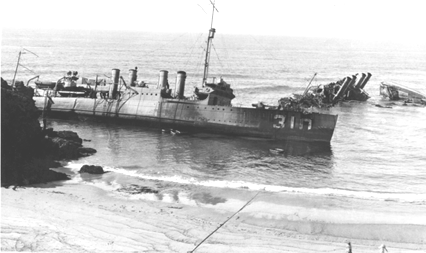
The first S. P. Lee (DD-310) was laid down on 31 December 1918 by the Bethlehem Shipbuilding Corp., San Francisco, Calif., Iaunched by Mrs. Thomas J. Wyche; and commissioned on 30 October 1920, Comdr. G. T. Swosey, Jr., in command. Assigned to Reserve Destroyer Division, Pacific Fleet, S. P. Lee spent most of her first two years in the San Diego area with a reduced complement. She sailed on 6 February 1923 as part of Destroyer Squadron 11 for combined fleet operations in the Canal Zone. Arriving Balboa 20 days later following exercises en route, the destroyer engaged in tactical and strategic maneuvers through the end of March and returned to San Diego on 11 April. From 25 June to 30 August, S. P. Lee and DesRon 11 cruised the coast of Washington putting in to Tacoma, Port Angeles, and Seattle and serving as escort to President Warren Harding in Henderson on his arrival at Seattle on 27 July. She then participated in squadron maneuvers through the end of August with Battleship Division 3, putting in to San Francisco on the 31st. S. P. Lee was struck from the Navy list on 20 November.
DD-311 Nicholas
| Other Names: | Date of Sinking: 8 Sept. 1923 | |||
| Rig/Type: | Cause of Sinking: Stranded | |||
| Length: 314' | Breadth: 30' | Tons: 1,190 | Cargo: | |
| Built: 11 January 1919 | Location: Off Pt. Pedernales | |||
| Hull Construction: Steel | Coordinates: Available to CWD Members | |||
| Depth: 0-20' | Visibility: 0-20' | |||
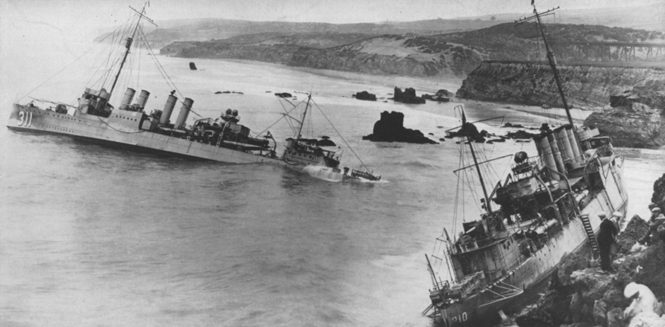
The Nicholas (DD-311) points in a westerly direction with its stern awash. The S.P. Lee (DD-310) is visible on the rocks to the right.
The first Nicholas (DD 311) was laid down 11 January 1919 by Bethlehem Shipbuilding Corp., San Francisco, Calif.; launched 1 May 1919, sponsored by Miss Edith Barry and commissioned at Mare Island Navy Yard 23 November 1920 Lt. Comdr. H. B. Kelly in command. Assigned to Reserve Destroyer Divisions, Pacific Fleet, Nicholas departed Mare Island 17 December 1920 for San Diego, arriving on the 20th and remaining principally in that area with a reduced complement through 1922. The destroyer sailed 6 February 1923 as part of Destroyer Squadron 11 for combined fleet operations in the Canal Zone. Arriving Balboa twenty days later following exercises en route, the warship engaged in tactical and strategic maneuvers through the end of March and returned to San Diego 11 April. From 25 June to 31 August, Nicholas and DesRon 11 cruised the coast of Washington, putting in to Tacoma, Port Angeles, and Seattle and serving as escort to President Warren Harding in Henderson on his arrival at Seattle 27 July. She then participated in squadron maneuvers through the end of August with Battleship Division 3, putting in to San Francisco on the 31st. Nicholas was struck from the Navy List.
| Other Names: | Date of Sinking: 8 Sept. 1923 | |||
| Rig/Type: | Cause of Sinking: Stranded | |||
| Length: 314' | Breadth: 31' | Tons: 1,190 | Cargo: | |
| Built: January 28 1919 | Location: Off Pt. Pedernales | |||
| Hull Construction: Steel | Coordinates: Available to CWD Members | |||
| Depth: 10-20' | Visibility: 0-25' | |||
The first Young (DD-312) was laid down on 28 January 1919 at San Francisco, Calif., by the Union Iron Works Plant of the Bethlehem Shipbuilding Corp.; launched on 8 May 1919; sponsored by Mrs. John R. Nolan; designated DD-312 on 17 July 1920; and commissioned on 29 November 1920, Lt. H. J. Ray in command. Young fitted out at the Mare Island Navy Yard into December. Assigned to Division 34, Squadron 2, Pacific Fleet Destroyer Force, the destroyer remained inactive in the San Diego area through the end of 1921. Shortages in both personnel and funds meant curtailed and reduced operations for the large number of destroyers that the Navy found itself with in the period immediately following World War I. The "rotating reserve" system kept the ships and their comparatively skeleton crews occupied. One third of a unit would lie alongside a pier, manned by only a bare maintenance crew; one third of the ships would lie in the stream at San Diego harbor in a half-manned status; while the last third would be fully manned but would remain in harbor most of the time. The destroyers were moved from one status to the other periodically, and, in spite of the reduced-manning and operations schedule, the ships maintained a high state of readiness. Young departed San Diego on 14 January 1922, bound for Bremerton, Wash., and, proceeding via San Francisco, Calif., reached the Puget Sound Navy Yard on the 18th. Overhauled at Puget Sound, the destroyer departed the yard on 3 April and arrived at her home port, San Diego, on the 8th. The remainder of the year passed fairly uneventfully, with the destroyer continuing her largely anchored existence in San Diego harbor. However, she did fire short-range battle practices, operated briefly off the Mexican Coronados Islands, and recovered torpedoes for Idaho (BB-42) during the autumn of the year 1922. The in-port routine changed the following year, when Young departed San Diego on 6 February 1923 and headed for Panama. En route, she stopped briefly at Magdalena Bay the traditional target Practice grounds for the Pacific Fleet and fueled from Cuyama (AO-3) before proceeding on south to the Pacific side of the Panama Canal Zone. Young participated in Fleet Problem I over the ensuing weeks. In this, the first Fleet Problem held by the United States Navy, the Battle Fleet was pitted against the Scouting Fleet the later augmented by a division of battleships. During the war games, Young performed antisubmarine screening for the dreadnoughts of the Battle Fleet and, when the scenario of exercises called for it, dashed in and made simulated torpedo attacks on the "enemy" battlewagons of the augmented Scouting Fleet. Upon completion of one phase of the exercises, she was present in Panama Bay when Secretary of the Navy Edwin Denby, accompanied by a party of congressmen embarked in the transport Henderson (AP-1), reviewed the Fleet on 14 March. Young later departed Panamanian waters on 31 March and arrived back at San Diego on 11 April. She remained there until 25 June, when she headed north. She called at San Francisco from the 27th to the 29th and arrived at Tacoma, Wash., on 2 July. Two days later, in keeping with the occasion, Young sent her landing force ashore to march in Tacoma's Independence Day parade. After shifting to Seattle Young underwent a period of upkeep alongside Melville (AD-2) between 16 July and 17 August. During that time, on 23 July, President Warren G. Harding, on a cruise to Alaska in Henderson, reviewed the Fleet one of his last official acts before his death a short time later. After spending a few days at Lake Washington following her upkeep period alongside Melville, Young underwent a brief yard period at the Puget Sound Navy Yard before she sailed south, escorting Battle Division 4 to San Francisco Bay at the end of August. En route, Young practiced torpedo attacks through smoke screens as part of the slate of tactical exercises. Following a brief period moored at Pier 15, San Francisco, Division 11 got underway to return to San Diego on the morning of 8 September. Decommissioned on 26 October 1923, Young was stricken from the Navy list on 20 November 1923 and ordered sold as a hulk.

Photos courtesy of J.P. Moore
| Like to learn more about this wreck? Visit our Guest Page to submit your inquiry. |
